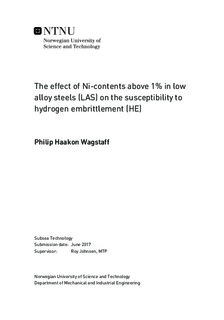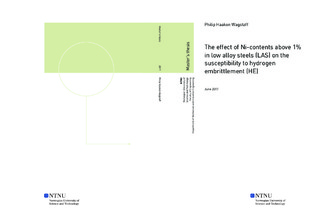| dc.description.abstract | Low alloy ferrite-pearlite steels with 0, 1, 2, and 3 wt% Ni were tested to evaluate the effect of exceeding the 1 wt% Ni (Nickel) restriction in ISO 15156:2. A literature survey was conducted to document the history of the Ni-restriction, hydrogen embrittlement of ferrite-pearlite steels, and existing literature on hydrogen embrittlement of ferrite-pearlite steels with Ni.
The materials were characterized by their overall microstructures, average grain sizes, relative fractions of pearlite, and the interlamellar spacing of pearlite. One of each alloy was tested in an ambient environment, two of each alloy were tested in a 3.5 wt% NaCl-solution with potentiostatic hydrogen charging, and two of each alloy were tested in a 3.5 wt% NaCl-solution with galvanostatic hydrogen charging. The irreversible trapping behaviour of the 0 wt% Ni and 3 wt% Ni samples were evaluated by charging them with hydrogen and storing them in a desiccator for 11 days before slow strain rate testing them. The surfaces and side views of all the tested specimens were examined by use of scanning electron microscopy (SEM).
Using potentiostatic charging, the alloys with 0 wt% Ni were seen to be least susceptible to hydrogen embrittlement. However, the alloys with 1 wt% Ni were only slightly more susceptible, and there were no major differences in the susceptibilities of the samples with 1, 2, and 3 wt% Ni.
With galvanostatic charging, a higher current was used, and the samples with higher Ni-contents were seen to be more susceptible to hydrogen embrittlement. When isolating the effects of the studied microstructural features and comparing them with other studies, the increased susceptibilities of the Ni-containing samples were deemed to be higher than what would have been expected.
In the test series where the irreversible trapping behaviour was evaluated, the alloy with 3 wt% Ni was seen to cause more irreversible trapping of hydrogen than the alloy with 0 wt% Ni. However, it was unclear whether this was due to the increased pearlite fraction of the sample with 3 wt% Ni.
For all alloys tested, the embrittling behaviour could be classified as a loss in tensile ductility. No differences were found in the fracture morphologies of the samples. In the Ni-free alloy, there were more secondary cracks along the gauge area. However, the cracks in the Ni-containing alloys were more severe. | |

